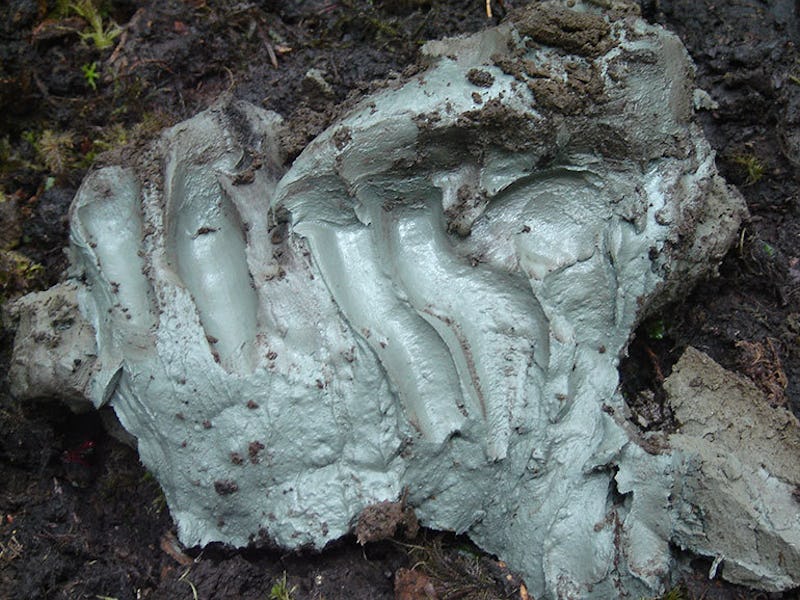Is This Ancient Clay the Antidote to the World's Toughest Bacterial Infections?
Eat dirt. It might just save your life.

Here’s the story: A 10,000-year-old deposit of clay exists in a remote pocket of Canada’s west coast. People of the Heiltsuk First Nation say grayish green has healing properties, and there are anecdotal reports of using it topically on wounds, as well as eating it to heal internal illnesses.
Around the world different clay deposits have been the subject of claims they have healing powers. For example, Dead Sea mud has seen its share of acclaim, but there are many others. Still, modern medical research has largely ignored the potential of clay — it has not been tested and approved as medicine.
A shovelful of clay from Kisameet Bay, British Columbia.
Now, a small company forms to exploit the potential of this particular clay deposit, located in Kisameet Bay, British Columbia, for potential cosmetic uses. They send clay samples to a microbiology lab at the University of British Columbia to test if it has antibiotic properties.
It’s a simple test — mix clay with water, add common bacteria, and see if they die. They do.
Senior researcher Julian Davies is intrigued, and he starts to test the clay on tougher, drug-resistant strains of bacteria that he has collected and cultivated in his lab.
The clay and water solution — nearly clear after the solids are pulled out — kills these untreatable pathogens.
Surprised? Davies was. “Very much,” he tells Inverse.
The results of the research were published this week in mBio. Shekooh Behroozian, a researcher in Davies’ lab, is the lead author.
University of British Columbia researchers Shekooh Behroozian and Julian Davies with a bucket of clay.
These are strains of bacteria that have become resistant to everything in the modern-medicine toolkit, and it’s a huge problem. They’ve been labeled the ESKAPE group of pathogens (Enterococcus faecium, Staphylococcus aureus, Klebsiella pneumoniae, Acinetobacter baumannii, Pseudomonas aeruginosa, and Enterobacter), an allusion to their persistent ability to evade treatment.
“I’ve worked on antibiotic resistance for a long time, and the ESKAPE pathogens have become more and more serious, and they’re a major threat in all hospitals, in all surgical wards, and also in outpatients,” says Davies. “It’s clear that they’ve been identified by regulatory agencies like the FDA and people like this as a major problem in infectious disease.”
In this biological arms race, the bacteria keep getting stronger, and medical research has fallen behind.
“There is an urgent, immediate need for new agents with activity against these panresistant organisms,” wrote authors of a 2009 article published in Clinical Infectious Diseases. “There is no evidence that this need will be met in the foreseeable future.”
The infections are essentially untreatable, and are a significant contributor to cause of hospital deaths.
Imagine Davies’ surprise to find that minerals leeched from clay into a water suspension effectively kills these bugs.
“The clay really did a good job of killing them all. It’s not a cure at the moment, it’s not a treatment, because the clay hasn’t been approved or anything like this, but I suppose in last-resort situations it could be used,” he says.
“Clays, and things like this, they are the products of health food stores and naturopathic stores, and things like this. This is why I was so surprised at the way in which it works.”
It’s not totally true that this clay is previously untested in Western medicine. There are records of its use during World War II in Vancouver hospitals as a topical treatment for burns and wounds, says Davies. But the records are not good. We know little about how effective it was, or what the side effects may have been.
We also still know very little about the composition of the clay, and the mechanism through which it acts on the bacteria, Davies says.
Beautiful Kisameet Bay in British Columbia, Canada.
He suspects that the particular composition of minerals and metals in the clay is responsible in some way.
“My feeling is that a clay with these kinds of properties is probably a result of something specific in the Earth or the atmosphere of this particular region where it’s isolated. So for example, the Kisameet clay is found in quite a large area, I haven’t seen it but there are photographs of it — a large patch of land which is very close to the coast. And it’s only there where you find the active material. And so you have to wonder, how did that get formed? And it was probably formed by extinct volcanoes, originally. And being able to reproduce the mechanism by which it was formed I think would be very difficult.
We think it’s a very fascinating topic. It’s so complex, the clay. It’s not like a compound or a bacteria that you can isolate a compound from, it’s really a complex mixture. It’s going to take more work from not just microbiologists but physicists and chemists and mineralogists and people like this who have real expertise in looking at the structure and function of these things.”
Fortunately, a team of scientists at the university from various disciplines are already working on it.
It’s not likely we’ll see a clay-based antibiotic treatment any time soon, says Davies. It would take a development team with experience bringing new products into therapeutic use, and then years of testing.
But in a life-or-death scenario, what person with an untreatable infection wouldn’t drink a glass of metallic-tasting water that had been shown to be deadly to the offending strain of bacteria?